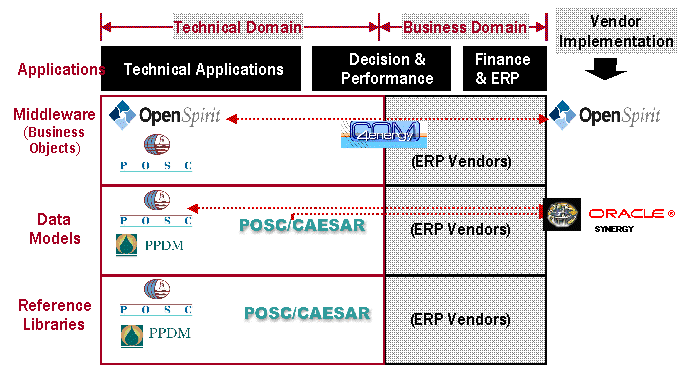
PDM has been tracking developments in standards and interoperability over the last couple of months. We have noted the recent additions of Synergy and Com for Energy (PDM Vol. 4 N° 2) and have attempted to map out who is doing what and where. I was therefore very interested in a new analysis, presented at the spring POSC member meeting, which John Hanten, POSC’s Chairman, was kind enough to let us reproduce here.

spectrum
The horizontal axis shows the spectrum of E&P IT from geotechnical to financial, while the vertical axis shows the different components. The overlap between POSC and PPDM in the data modeling area is clearly evident. Which leads us to the first good news of the month. Despite the first two attempts at ending in tears, these organizations are going to have another bash at sharing resources.
reference libraries
The erstwhile sparring partners are to bury the hatchet and work together to produce a common set of codes (reference tables). This will mean that items such as log mnemonics, well completion nomenclature and the like will be the same across the two databases. Lets hope they manage to align this effort with IHS Energy who have just been there and are doing that (see this month’s front page).
Interop space
Going back to POSC’s analysis below, the scope of the three vendor-driven interoperability initiatives can be seen as follows. Open Spirit is ambitiously positioned middleware which will ultimately cover the whole spectrum of IT. Synergy’s positioning is similarly broad in scope. COM for Energy is significantly more focused, aiming at the interface between the technical and commercial worlds.
PC vs. UNIX
A dimension that is not clear from the present analysis is the targeted platform for the initiatives. I think that, despite vendors valiant efforts to present an ‘integrated’ front with interoperability extending across both Windows and UNIX, the reality of the Interop space is more entrenched. The COM for Energy focus, rather than embracing UNIX, is currently more interested in ‘cherry picking’ high value PC applications.
CORBA for Geoshare
Another field of cooperating standards was evidenced by Jim Theriot’s paper at the PNEC Data Integration conference. Here a cooperative effort between POSC and Geoshare is web-enabling Geoshare by ‘wrapping’ the data model with CORBA IDL. This effort is part of the elegantly named Geoshare Webification SIG!
merge?
Should the standards organizations merge? I believe that there is a lot of damaging confusion caused by having a multiplicity of E&P IT standards, but on the other hand I am inclined to say ‘vive la différence’. The advantage of the status quo is that the champions of say, a logical data model, RP66, or Oracle DDL can all optimize their wares without a central body arbitrating the research effort up-front.
help required!
A more pressing issue is the fact that membership of these organizations is declining, and the demographics have shifted in favor of software vendors as opposed to oil companies. Without painting the vendors as machiavellian, their agenda is different. So if you believe that common industry-wide reference tables would be a good thing; join up! What the standards organizations need most right now is more input from genuine end-users.
sign up here
Hopefully some of these initiatives will inspire some of you to lend a hand. Take your pick from the following
www.posc.org
www.geoshare.org
www.ppdm.org
and make sure that your voice is heard!
Click here to comment on this article
If your browser does not work with the MailTo button, send mail to
pdm@oilit.com with PDM_V_3.3_9905_3 as the subject. © Oil IT Journal - all rights reserved.